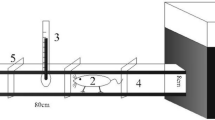Abstract
GAPING is a characteristic activity of several species of crocodilians in which the animal lies ashore with its mouth held open for prolonged periods1–4. It has stirred the interest of humans for millennia: gaping is depicted in Egyptian papyri and was mentioned in the writings of Herodotus and Pliny. Today interest continues in gaping and other aspects of behaviour in these large reptiles, the last of the subclass Archosauria, the group of reptiles that included the dinosaurs1,5. Gaping is a complex habit that involves variable degrees of mouth closure and sometimes includes rhythmic gular movements. Behavioural observations have suggested that gaping is a thermoregulatory response3,4 but until now physiological studies have been inconclusive. Initial reports6 stated that gaping was effective in cooling young Nile crocodiles (Crocodylus niloticus) but a recent experiment on Caiman crocodylus indicated that this behaviour had no thermoregulatory significance7. Here we present evidence from controlled laboratory and field experiments that gaping is an effective mechanism for reducing head temperatures of alligators (Alligator mississippiensis). Gaping reduced the rate of heat gain by the heads of small and large alligators when these animals were exposed to high light radiation loads at moderate air temperatures. The magnitude of this effect increased with size. Gaping had little effect on body temperature and did not reduce the final equilibrium temperature of the head.
This is a preview of subscription content, access via your institution
Access options
Subscribe to this journal
Receive 51 print issues and online access
$199.00 per year
only $3.90 per issue
Buy this article
- Purchase on Springer Link
- Instant access to full article PDF
Prices may be subject to local taxes which are calculated during checkout
Similar content being viewed by others
References
Neill, W. T., The Last of the Ruling Reptiles (Columbia University, New York, 1971).
McIlhenny, E. A., The Alligator's Life History (Christopher, Boston, 1935).
Cott, H. B., Trans. zool. Soc. Lond., 29, 211–337 (1961).
Johnson, C. R., Comp. Biochem. Physiol., 49A, 3–28 (1974).
Graham, A., and Beard, P., Eyelids of Morning (A and W Visual Library, New York, 1973).
Cloudsley-Thompson, J. L., Br. J. Herp., 4, 107–112 (1969).
Diefenbach, C. O. da C., Copeia, 1975, 530–540 (1975).
Terpin, K. M., Dodson, P., and Spotila, J. R., Copeia, (in the press).
Spotila, J. R., Lommen, P. W., Bakken, G. S., and Gates, D. M., Am. Nat., 107, 391–404 (1973).
Smith, E. N., Physiol. Zool., 49, 37–48 (1976).
Gates, D. M., Energy Exchange in the Biosphere (Harper and Row, New York, 1962).
Spotila, J. R., and Berman, E. N., Comp. Biochem. Physiol., 55A, (in the press).
Grigg, G. C., and Alchin, J., Physiol. Zool., 49, 24–36 (1976).
Pough, F. H., and McFarland, W. N., Comp. Biochem. Physiol., 53A, 301–303 (1976).
Spotila, J. R., Soule, O. H., and Gates, D. M., Ecology, 53, 1094–1102 (1972).
Author information
Authors and Affiliations
Rights and permissions
About this article
Cite this article
SPOTILA, J., TERPIN, K. & DODSON, P. Mouth gaping as an effective thermoregulatory device in alligators. Nature 265, 235–236 (1977). https://doi.org/10.1038/265235a0
Received:
Accepted:
Issue Date:
DOI: https://doi.org/10.1038/265235a0
This article is cited by
-
Hot and covered: how dragons face the heat and thermoregulate
Journal of Comparative Physiology B (2021)
Comments
By submitting a comment you agree to abide by our Terms and Community Guidelines. If you find something abusive or that does not comply with our terms or guidelines please flag it as inappropriate.



